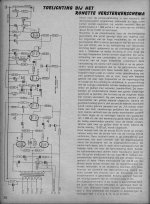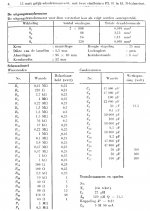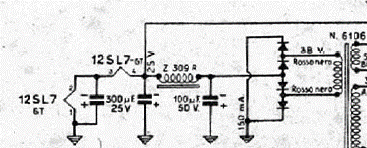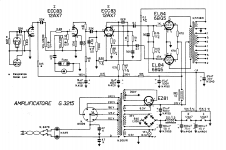Hi all,
I'm looking for a schematic with EBL21 in push pull configuration. So far, what I've found on the other forums, are incomplete schematics, with no data about OT.
Thank you in advance.
I'm looking for a schematic with EBL21 in push pull configuration. So far, what I've found on the other forums, are incomplete schematics, with no data about OT.
Thank you in advance.
Attachments
Almost all EL84 schematics can be used. 8k or 10k OPT works fine.
Unfortunately I can't find any OT (eg hammond) with Ra = 9000k.
From the 8K, 10k which one would be most appropriate?
Unfortunately I can't find any OT (eg hammond) with Ra = 9000k.
From the 8K, 10k which one would be most appropriate?
8K works great for me.
Also 6600 is suitable.
Unfortunately I can't find any OT (eg hammond) with Ra = 9000k.
From the 8K, 10k which one would be most appropriate?
You can also play with the impedance, by connecting the speaker to a different output tap, for example:
OT 4.5k primary, secondary 4 and 8 ohm taps, connect an 8 ohm speaker to the 4 ohm output tap:
((sqrt(4500/4))^2)*8 = 9000
I have an old radio with that tube and when I need a replacement it vas was hard to find and expensive beacuse projects like this.Not to mention EM4 which price skyrocketed beacuse it was popular for diy VU-meters.
My suggestion to you is to leave EBL21 tubes to radio restorers and use 6V6 instead. Russian NOS version is cheap and good and you have several in current production to.
My suggestion to you is to leave EBL21 tubes to radio restorers and use 6V6 instead. Russian NOS version is cheap and good and you have several in current production to.
I have an old radio with that tube and when I need a replacement it vas was hard to find and expensive beacuse projects like this.Not to mention EM4 which price skyrocketed beacuse it was popular for diy VU-meters.
My suggestion to you is to leave EBL21 tubes to radio restorers and use 6V6 instead. Russian NOS version is cheap and good and you have several in current production to.
I already have around 20 EBL21 tubes. I'm not going to ruin them, I take care of old and rare tubes.
EBL21 is really an audiophile tube and deserves to be used in an tube amplifier (my opinion), that's why I asked for the help of tube specialists for a functional push-pull schematic (which really works, I am not interested in experiments considering that these tubes are rare).
From the 8K, 10k which one would be most appropriate?
That depends on the supply voltage. For 300 V or more, take 10k.
For 250V to 300 V take 8k.
Attached two schematics as published in Dutch electronics magazines from the mid fifties.
The one from 1955, of which you than only use the part with the ECC40 and 2 x EBL21, lacks GNFB.
The one from 1954 does have GNFB but my guess is that if you would only use the ECC40 and 2 x EBL21 than the input sensitivity will be a bit low.
Several radios were made with 2 x EBL21 in push-pull but a substantial part of them used an ECH21 as a combined AF amplifier and phase inverter, which in view of sound quality (distortion) is probably not the best way to go.
But like others already pointed out: You can pretty much use any schematic for a push-pull amplifier with 2 x EL84, but than follow the datasheet for the EBL21 as far as the cathode resistors and the anode to anode load for the EBL21's are concerned.
The one from 1955, of which you than only use the part with the ECC40 and 2 x EBL21, lacks GNFB.
The one from 1954 does have GNFB but my guess is that if you would only use the ECC40 and 2 x EBL21 than the input sensitivity will be a bit low.
Several radios were made with 2 x EBL21 in push-pull but a substantial part of them used an ECH21 as a combined AF amplifier and phase inverter, which in view of sound quality (distortion) is probably not the best way to go.
But like others already pointed out: You can pretty much use any schematic for a push-pull amplifier with 2 x EL84, but than follow the datasheet for the EBL21 as far as the cathode resistors and the anode to anode load for the EBL21's are concerned.
Attachments
Last edited:
I already have around 20 EBL21 tubes. ...I am not interested in experiments considering that these tubes are rare).
They are not rare at all.
They are extremely common and easy to get.
They were made by Telam and many other eastern European companies by the 100s of 1000s for USSR/Serbian etc radios.
When I wanted to get a few recently it was dead easy, and they cost peanuts.
They have some extremely interesting characteristics which is why I went to the trouble of getting mil spec loctal sockets for them and enough to make matched pairs and matched quads.
You will find valid data is exceptionally scarce, because nobody ever ran them before, fixed bias and as matched quads.
Several radios were made with 2 x EBL21 in push-pull but a substantial part of them used an ECH21 as a combined AF amplifier and phase inverter, which in view of sound quality (distortion) is probably not the best way to go.
What about EF22...these are pretty same to ECH21? (I mean in "audiophile" terms)
But like others already pointed out: You can pretty much use any schematic for a push-pull amplifier with 2 x EL84, but than follow the datasheet for the EBL21 as far as the cathode resistors and the anode to anode load for the EBL21's are concerned.
Slowly I approach the same opinion. Do you have any functional and tested schematic with EL84?
Regards!
Like the heptode section of the ECH21, the EF22 has vari-mu characteristics as to make AVC with reasonable sound quality in the HF and IF stages of radios possible. But tubes with these characteristics often create more distortion when used in AF applications than tubes without these characteristics.
The question for a good schematic with EL84's has been posted, and answered, many times on this forum so I advise you to search for threads like that. I never made an amplifier with EL84's myself so I think others who did can advise you on this better than I could.
The question for a good schematic with EL84's has been posted, and answered, many times on this forum so I advise you to search for threads like that. I never made an amplifier with EL84's myself so I think others who did can advise you on this better than I could.
Probably off topic but in this class B amplifier the bias for the 2 x PL81 and the (triode connected) pentode section of the ECL80 are produced by the triode section of the ECL80 which is connected as an oscillator (2 MHz). In the book it says that about any AM oscillator coil can be used for L1/L2.
Warning: This amplifier has no seperation from the mains so would be dangereous if the chassis could be touched during use (hence the two input capacitors, the capacitor to the ground connection and no connection between the chassis and the loudspeaker outputs).
Warning: This amplifier has no seperation from the mains so would be dangereous if the chassis could be touched during use (hence the two input capacitors, the capacitor to the ground connection and no connection between the chassis and the loudspeaker outputs).
Attachments
Last edited:
I am really enjoying looking at these old schematics these days, for the clever tricks employed by these masters of their craft. Perhaps there should be a thread for this?
Here is another clever one - regulated bias, heater supply and it is also rectified, all in one.
I have been working on some 1930's radios recently, and there is so much that is done differently before a uniform approach to the common problems was adopted.
Here is another clever one - regulated bias, heater supply and it is also rectified, all in one.
I have been working on some 1930's radios recently, and there is so much that is done differently before a uniform approach to the common problems was adopted.
Attachments
It could also function as a kind of safety feature for when the filament of one of the 12SL7's gets interrupted (by defect or if the tube is taken out of its socket). The effect being that the bias becomes much more negative and the other 12SL7 stops working too.
Last edited:
This circuit is a distintive feature of small PA amplifiers built by Geloso in Italy after the war. It was a very successful design because it was dependable, easy serviceable, at a lower cost than most alternatives. The design has been finalized on the 1949 PA amplifiers lineup and remained in production for two decades, with minimal variations. On the last models, 12AX7 replaced the 12SL7. The manufacturer literature does not mention the protection featured when a tube is missing, but this surely has been a consideration.
The Geloso company founder was the chief engineer of the Pilot Electrical Manufacturing company in the '20 and a tecnical consultant of the Radio Design magazine. As example, an article about one of its designs is on the winter 1929 issue of Radio Design (vol1 number4).
Another quirk of this design are the asymmetrical power tubes grid stopper resistors. The resistor value of the top tube is much lower than the one of the lower tube, and the tube with lower resistor value does have an extra small value capacitor to cut the bandwith, presumably to bring it in the same range of the lower tube. I attach the schematic of the G3215 model. I don't understand the purpose of this asymmetry. The specified bandwith of the amplifier is 30Hz - 10kHz. It is now sometimes repurposed as musical instrument amplifier because it does have a pleasant warm sound.
The Geloso company founder was the chief engineer of the Pilot Electrical Manufacturing company in the '20 and a tecnical consultant of the Radio Design magazine. As example, an article about one of its designs is on the winter 1929 issue of Radio Design (vol1 number4).
Another quirk of this design are the asymmetrical power tubes grid stopper resistors. The resistor value of the top tube is much lower than the one of the lower tube, and the tube with lower resistor value does have an extra small value capacitor to cut the bandwith, presumably to bring it in the same range of the lower tube. I attach the schematic of the G3215 model. I don't understand the purpose of this asymmetry. The specified bandwith of the amplifier is 30Hz - 10kHz. It is now sometimes repurposed as musical instrument amplifier because it does have a pleasant warm sound.
Attachments
Here's the shematics of a Polish(?) radio with three ECH21's and a pair of EBL21's in the signal path. The last ECH21 is the AF preamplifier (heptode tied as a pentode and triode as a Paraphase inverter), the EBL21's as the PP power amplifier with semi-automatic bias.
I also recall a schematics in the Röhren-Handbuch by Ludwig Ratheiser (German author of mainly tube related literature). It's an audio amplifier featuring each two ECH21's and EBL21's with a similar PI and power section. Unfortunately I don't have my 1996 reprint of that 1955 book handy at the moment.
I don't see no reason why remote cutoff tubes shouldn't be used in audio purposes. The EF83, for instance, has been derived from the EF86 for exactly that (automatic level control in tape recorders).
Best regards!
I also recall a schematics in the Röhren-Handbuch by Ludwig Ratheiser (German author of mainly tube related literature). It's an audio amplifier featuring each two ECH21's and EBL21's with a similar PI and power section. Unfortunately I don't have my 1996 reprint of that 1955 book handy at the moment.
I don't see no reason why remote cutoff tubes shouldn't be used in audio purposes. The EF83, for instance, has been derived from the EF86 for exactly that (automatic level control in tape recorders).
Best regards!
- Home
- Amplifiers
- Tubes / Valves
- EBL21 PP amplifier - lookong for schematic






